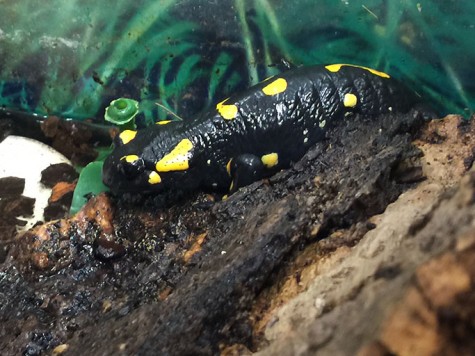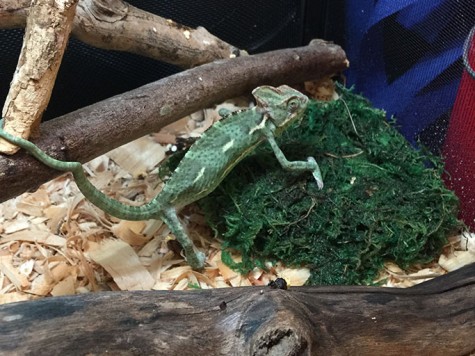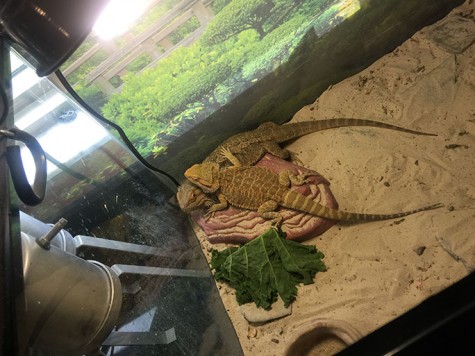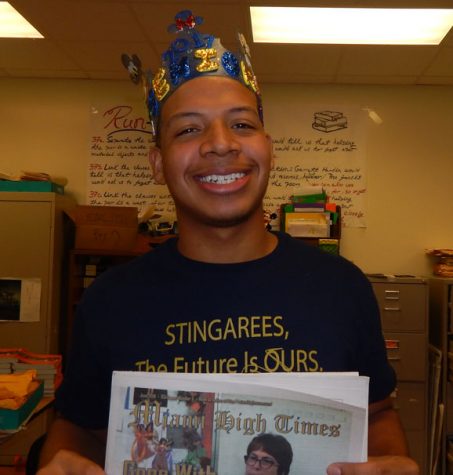Zoo Miami High
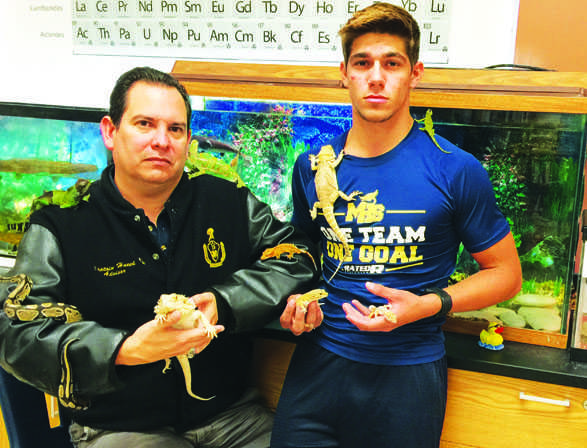
Dr. Hueck and Senior Nick Mira holding reptiles.
Animals are amusing and wonderful to be around, but animals in a classroom might be out of place.
Marine science teacher Mr. Upperco, who keeps a snake and a spider in his classroom, said, “The reason you put animals in a classroom is to use them as a teaching tool.”
You pick out certain animals students will be frightened to see or touch in the wild, but in a classroom, those animals can relieve the students of that fear.
“I only do cold blooded animals,” Mr. Upperco said. I stopped getting mammals 15 years ago because mammals have to eat everyday while cold blooded creatures can go without eating for days.”
Junior Mayeling Cruz, who takes Mr.Upperco marine science class, said, “They are used as a class example so we could see with our own eyes in person, not in books, how they really act.”
Dr. Hueck’s chemistry classroom #3302 houses a variety of animals. Senior Nick Mira, whom Dr. Hueck chose to care of the animals, said they have a bearded dragon, mouse, rabbit, water dragon, Madagascar day lizard, leopard geckos, hedgehog, a turtle, salamander, frog, four freshwater fish tanks and 1 salt-water fish tank.
Nick said, “They all eat once a day in the morning. We feed them crickets and worms and silver slides (frozen fish food) and flakes.”
You might wonder how do the animals get fed during the weekend or during long breaks? Nick said, “Usually Dr. Hueck, biology teacher Mr. Sanchez, or I will go to school to feed them.”
If you have noticed aquarium tanks in the library, that you might be expecting some more animals at Miami High.
School treasurer Mr. Jorge Portoundo said, “The tanks, which were donated by FPL, are still under construction. One is a 300 gallon reptile tank, which we haven’t placed any reptile in yet. We had a 300 gallon salt water tank, but while moving it for cleaning, we discovered it had cracked and had to be thrown away.”
As many animals as we have around the Miami High, some students would like to see more. Senior Kristina Feliciano said, “I would love to see a baby pig, a Ginger monkey, and an owl. No type of insects or bugs.”
Mayeling Cruz would like to see a rattle snake. “It’s an important reptile to nature that a lot of people are scared of,” she said.
Junior Vanessa Jaime would like a tarantula or something cool.
Wouldn’t having more animals in class be distracting? Vanessa doesn’t think so. “You just have to focus on your own things that are going on. I am currently in Beta were there are many animals in our meeting room. They are used to entertain students when they are idle or done with work.”
Mayeling Cruz said, “They are part of the learning experience with Mr. Upperco. He has a snake, and while teaching us about reptiles, he spoke to us about what it eats and how long would it survive without eating. It’s not a distraction. It’s an amazing part of the class when you could actually see the animal in person.”
On the other hand, junior Estephfany Velasquez said, “I do believe animals are distracting, but if taken care of correctly, they could be an asset to teach students.”
According to the article “Pets Bring so Many New Ways to Learn” posted on the website Animalsinaclassroom (http://www.petsintheclassroom.org/teachers/benefits-of-classroom-animals/), “Whether it’s math (How much does a hamster weigh?), science (What does a snake eat?), geography (What part of the world do ferrets come from?), or vocabulary (What words would we use to describe a goldfish?), students will approach learning all these subjects with a new enthusiasm and interest. Other classes can even come visit your classroom pets and your students can create special presentations about the animals.”
